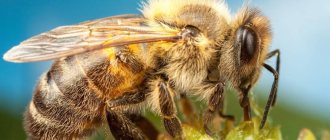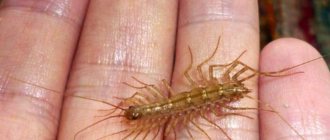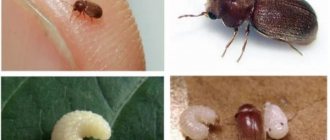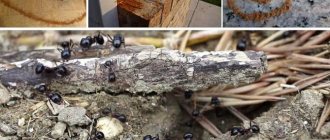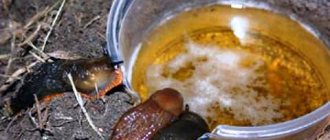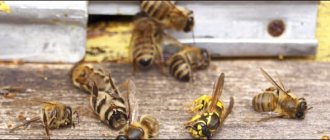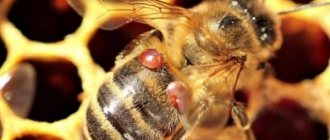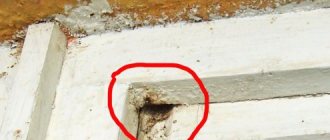We all, in one way or another, use beekeeping products, which have proven themselves on the positive side not only as a tasty food product. Since ancient times, people have used honey, bee bread, propolis, wax, and royal jelly for medical and industrial purposes. But it’s one thing to buy and use all this for its intended purpose, and quite another thing to extract it. A swarm of bees is not the most pleasant neighborhood.
A bee sting in itself is already an unpleasant and painful event. What if a person is allergic to bee venom? Everything can end tragically if medical assistance is not provided in time.
Most people encounter bees that pollinate gardens and vegetable gardens. The characteristic buzzing makes you move away from the tree or flower bed. But what to do if, due to the many bees, it is simply impossible to go out into the garden? This happens when neighbors decide to put several hives right on their property. Bees will fly and collect flower nectar throughout the area. It turns out that one family will pump honey, and the neighbors around will only suffer? There are several ways to solve the problem.
How to get rid of your neighbor's bees peacefully
Any problem must be resolved peacefully. If a neighbor who keeps a small apiary at home is a peace-loving person, then he will make contact in any case. There are several completely acceptable solutions to the problem that can be offered to a beekeeper neighbor:
- turn the hives in the direction opposite to your site;
- place the hives at a distance of more than 30 meters from residential buildings;
- put a blind fence more than 2 meters high at the boundary;
- plant fast-growing trees and shrubs along the fence on the neighbor’s side;
- change the aggressive bee colony, including the queen.
Solving the problem peacefully will help maintain good neighborly relations. Otherwise, you will have to contact law enforcement agencies, which, no doubt, will ruin the relationship, but will preserve your health.
Solving the problem with the help of law
If, after all the negotiations, the owner of the apiary does not take any measures and the bees continue to interfere with a peaceful life, the issue will have to be resolved with the involvement of law enforcement agencies.
To begin with, you can contact the local police officer or the head of the gardening association with a complaint. If even after this there is no reaction from the neighbor, then you will have to go to court. But to do this, we need to collect as much evidence as possible that bees greatly impair the quality of life. The evidence base may include the following documents:
- Certificates from a doctor confirming receipt of bee stings.
- Photo or video indicating the distance of the apiary from the border of your site.
- Measurement data for the height of the fence at the boundary.
- Photo or video evidence that bees are swarming on your property.
- Data from your request for training the beekeeper on the rules of behavior in the event of a bee attack, as well as the availability of an apiary passport and a beekeeping record book.
A careless beekeeper who does not respond in any way to requests from neighbors to solve the problem may be held accountable under Article 17 Part 3 of the Constitution of the Russian Federation for violating the rights and freedoms of others and Article 10 of the Federal Law for violating sanitary standards.
Is it possible to get rid of bees yourself?
If you don’t want to spoil your relationship with your neighbors, you can try a humane way to get rid of a bee infestation. On your site you will have to remove all open sources of water where bees fly to quench their thirst. To discourage insects from looking for water from you, you can pour granulated sugar into containers with water. They will stop bothering you.
If a person does not admit that he keeps an apiary, and the urgent question is how to get rid of the neighbor’s bees, more radical methods will do. One of them is the use of insecticides. Any toxic substance must be diluted according to the instructions. Most often, the product is added to honey water. Bees will be attracted to sweet poison displayed in containers near the fence.
Salt water will also help get rid of bees. They die from the high content of table salt in the water. Not the most humane way to get rid of hated insects, but it is not punishable by law.
how to scare bees away from a pond
peoplesweet
It's a shame your neighbor doesn't take care of his bees. So he doesn’t have water on the property, I think so. Dad always placed dishes with water in the apiary so that a bee, when it arrived in the hive, could drink near its house.
Uncle B
Insects are quite mechanical in their behavior. They protect near the hive, collect nectar on flowers, and the hive protection function is turned off. Here they are just drinking water, there is nothing to be afraid of, the main thing is not to catch them with your hands.
Sergey S
It is almost impossible to train bees to one source of water; they will still drink where they like best, so the only way is to cover the barrels with something at a time when you do not need water in them. The bees will find another source and stop coming to you.
- How to attract bees
- How to lure bees into a hive
- How to lure bees into an empty hive
- How to attract bees
- What Attracts Bees
- How to repel snakes
- How to repel snakes
- Everything about bees and beekeeping for beginners
- Lure the bees
- Flowers to attract bees
- Flowers that attract bees
- Flowers for bees
- Bee baits
- How to plant vegetables correctly
- The best varieties of beets
- How to plant rose gardens
What scares you away
If you are unable to come to an agreement with your neighbor, and you don’t dare go to court or poison your neighbor’s bees, you can try to scare them away. There are several effective ways to repel insects:
- pieces of fabric soaked in essential oils of mint, cloves or mustard, an aroma lamp in the garden on a table are humane options for getting rid of bees that cannot tolerate odors;
- bags of mothballs, which can be hung on trees and in places where insects accumulate, can serve as repellers;
- near the fence you can plant a perennial herbaceous plant, catnip, the smell of which will prevent insects from entering your area;
- You can hang traps with vinegar near a container of water or along the fence, the smell of which bees don’t like;
- an audio recording of birds singing will create a special atmosphere in your garden and scare away bees;
- Purchased repellers with different operating principles are very effective in fighting insects, including bees.
Bee disease - acarapidosis: causes, symptoms, treatment, prevention
Important: In addition to the Varroa mite, the body of a bee can be parasitized by the tracheal mite.
Acarapis Vude mites are very small in size; they multiply in the trachea of bees, complicate breathing and lead to death. Damage to the trachea by this mite is called acarapidosis. Tracheal mites infect young bees, often the infection is associated with varroa.
Tracheal mite symptoms: weak bees crawling on the ground near the hive. But this symptom also applies to other infectious diseases. To clarify the diagnosis, the bee is sent to the laboratory, where the thoracic trachea is examined under a microscope.
For the treatment of acarapidosis, the same drugs are used as for the treatment of varroatosis.
Acarapidosis of bees
3
How to kill bees yourself?
It is difficult to drive away insects; considerable effort is required. The event begins at the end of winter, when the size of the colony is reduced to a minimum. When the nest is placed in a wall, the entrance to it cannot be sealed.
The hive can be located in a wall, foundation, roof or chimney. To destroy insects in the wall of a house, their type is first determined, since methods of controlling wasps or hornets for bees may not be effective.
Self-defense measures:
- no smoking;
- do not drink alcohol;
- do not use perfume with a strong odor;
- wear light, thick clothes;
- cover your head with a protective net;
- put gloves on your hands.
The nest, located in an open place, is fumigated with smoke. Newspapers, wood chips and grass are placed in the smoker. As a result of this action, the bees have a reflex to leave their nest and save the honey. They press the sting to the abdomen and cannot sting; the bite can be avoided.
Such work is carried out in the evening, when the worker bees have returned from the field and, most likely, it will be possible to destroy the entire colony. The nest is packed in a tight bag and poured with boiling water or burned.
In August, bees begin to reproduce, so even peaceful insects are attacked.
We recommend
How to make a bee trap with your own hands?
3.1
How to get rid of wild bees?
Wild bees can settle in an area located near a forest. Many beekeepers agree that it is not necessary to destroy such insects. They often make temporary nests. Scout bees will definitely find a more secluded place, and within a few weeks the queen will fly over, taking the entire swarm with her.
The aroma of their own poison excites the bees, and they perceive it as a signal to attack.
Individual individuals are destroyed with a soap solution. To do this, add 30 ml of liquid soap to 500 ml of water and set traps. You can add acetic acid to them.
Features of the bee dance and its meaning
3.2
How to deal with neighbor's bees?
Protection from neighbor's honey bees:
- 1. Bees arriving from apiaries are afraid of the aromas of peppermint and cloves. Therefore, you can protect yourself by covering your skin with these oils or a repellent based on them.
- 2. Insects dislike the smell of catnip and smoke. To prevent the appearance of a swarm of bees, a fire is lit in the area.
- 3. Place citronella candles in the bathhouse and garage, lay out bags of mothballs, and also hang them on the branches of fruit trees.
- 4. Bees look for water far from the apiary, so it is recommended to cover garden barrels, a swimming pool, and an artificial pond.
- 5. A tape recording of bird sounds helps to ward off a swarm of bees.
You need to place traps with a sweet solution carefully, otherwise you can disrupt the pollination processes of garden crops, which will lead to a small fruit harvest and poor flowering of plants in flower beds.
3.3
Fighting earth bees
These insects live in deep earthen burrows. The procedure for removing them cannot be carried out in the morning or afternoon, as the bees will launch an attack from the air. It is performed in the evening, when the whole family has returned from the meadows, or before dawn.
Prepare boiling water equal to 10 liters of water and fill the hole in the evening after dusk. First, pour in 5 liters of boiling water, then the rest. Pour water until it fills the entire hole. If the passages are not filled completely, the surviving bees will crawl out and attack. And finally, a poisonous substance is added. The entrance to the hole is filled with cement solution (3 kg of sand and 1 kg of cement).
3.4
Destruction of tree bees
These insects begin to fly in late spring or June. They like to live in coniferous wood on the sunny side.
Repellents are considered an effective deterrent. They are used with caution if there are small children or people with allergies in the house.
3.4.1
Repellents
The products are produced in the form of sprays, ointments, aerosols, pencils, creams, napkins. Sprays are effective for 3 hours in an apartment, creams protect longer. They operate on the same principle: they dampen the sense of smell of insects.
Types of funds:
- 1. Fumigants – means of collective protection (fumigators on plates, spirals).
- 2. Encapsulated suspensions - insect control products containing chlorperifos in capsule form.
3.4.2
Chemicals
Carpenter bees cause significant damage to wooden structures, which can lead to its complete destruction. The chemicals are easy to use; they can be diluted in water and coated with carpenter bee areas. There are several types of chemicals:
- 1. Pesticides are produced in powder form. They are dissolved in water and treated on the wooden surface in places where bees gather. The best pesticides are boric acid and carbaryl.
- 2. To poison insects in the attic, the surface is treated with diesel fuel or gasoline with great care, after which the insects quickly die.
- 3. Carburetor cleaner - an easy-to-use product. It is sprayed in the habitats of pests, which quickly fly away and never return.
- 4. Benzaldehyde is a poison with the smell of almonds. It is poured onto a piece of carpet and placed in a bee's nest.
- 5. Pests are afraid of vibrations and loud noise. You can install a radio near their habitat and turn it on at full volume. They will fly away from the nest and will not return soon.
Tree bees generally fly alone, so exterminating them can be difficult.
Bees are irritated by fur, hair and black clothing. In the process of evolution, they developed an instinct to protect themselves from pests of bee nests - martens and bears.
It is not always possible to get insects out of a wall or window sill. In this case, toxic substances are used:
- 1. Mosquitol is an aerosol that destroys blood-sucking insects and bees.
- 2. Arrivo is a long-term insecticide. The death of bees occurs after 20 days. Use with caution if there is an apiary nearby.
- 3. Domestos - a solution for disinfecting premises helps kill pests. They spray insect habitats with it.
- 4. Fas is used when bees are inside the house.
- 5. Actellik is a product with class 2 toxicity. Bee nests are sprayed with it.
If these remedies do not help repel bees, you need to contact the SES.
3.4.3
Traps
Stores sell traps for such pests. The device, similar to a decorative lantern, is suspended from a tree and helps remove insects while beautifying the area. You can make the bait yourself.
Tools and materials:
- wooden planks;
- screws and nails;
- screwdriver;
- hammer;
- plastic bottle;
- saw.
If bees are found inside the house, you must immediately begin eliminating them.
The procedure for making a trap:
- 1. Cut out 4 boards 20-30 cm long and fasten them together.
- 2. Make a roof that protrudes slightly at the edges, and the bottom is flush with the size of the house.
- 3. A hole with a diameter of 20 mm is drilled from below.
- 4. The top of the bottle is removed and the edges are cut so that they are secured with “petals” in the hole of the trap.
- 5. The bottom part of the bottle is inserted into the neck and the edges are secured with tape. The petals should extend beyond the edge of the adhesive tape at a distance of 1-2 cm.
- 6. Using “petals,” attach the bottle to the hole in the trap and pour soapy water into it.
They make a hook on which to hang the house on the sunny side of the site. You can also make more holes in it. The bees will fly towards the sweet smell of the detergent and get stuck in the trap.
The role of bees in pollination and nectar collection of different plant species
3.4.4
Repeller
Repellents may vary. Their design depends on the purpose: use in the home or open space. They also lack versatility. Powered by electricity, batteries, gas or solar:
- 1. Anti-mosquito lamps are used in food processing and storage areas. They differ in impact radius and power. Safe for pets or humans. Ultraviolet radiation attracts bees. When insects land on the device, they die from electric shock.
- 2. An anti-mosquito lamp with a range of 50 m is used at home; it harmonizes well with the interior of the room. Its service life is 5 years. The disadvantage of the device is that it is relatively expensive and can only be used indoors, since it runs on electricity.
- 3. The fumigator-based repeller operates from a gas cartridge. A plate is inserted into it, which, when heated, releases a toxic substance. It is used when fishing, in the garden or in the garden. The disadvantage of scaring away bees is that after a while they return.
- 4. Ultrasonic repellers are ineffective. Powered by salt or solar batteries. They are safe for people. More effective are devices that deliver magnetic pulses that help repel insects and kill them. The downside is the high cost and risk of harm to human health.
3.5
How to discourage thieving bees?
In windless, dry weather, due to a lack of bee food, bee colonies are stolen. The thieves do not linger on the arrival board and quickly make their way into the hive. The risk of being robbed is high in weak families and those without a womb.
Measures to combat thieves:
- 1. Reduce the entrance to the entrance so that 2 bees can enter at the same time.
- 2. Place a rag soaked in kerosene on the landing board. They also lubricate the upper edges of the tapholes.
- 3. Attacking thieves are sprayed with cold water, sunflower oil from a plastic bottle, or euthanized with ammonium nitrate from a smoker.
- 4. Make a tube 15 cm long from elderberry, sunflower stem or angelica and insert it into the tap hole, sealing the cracks with clay. Native bees will quickly master the new entrance, but it will be difficult for a stranger to penetrate.
- 5. The hives are covered with hay, leaving a small hole for entry. When leaving, the thieves get entangled in the hay, and the new arrivals lose their bearings and fly away.
- 6. A strip of glass measuring 25-50 cm is placed on the landing board at an angle to the entrance. The hole is narrowed for the passage of 3 bees. Strangers, when approaching the hive, are afraid of glass and fly away forever.
- 7. Flight boards and the outer walls of the hives, where thieves accumulate, are lubricated with diesel fuel. They stop flying even after a day.
- 8. The entrances are closed in the morning and a thick layer of table salt is poured onto the landing boards. After half an hour, the foreign pests fly away. After this, the tapholes are washed and the inlet hole is opened to the required size.
- 9. Near the entrance, wormwood is laid out and a small hole is left for the entry of thief bees. After 20 minutes, the extraneous bees fly away.
If the measures taken do not help, the entrance is covered with a net and removed for 3 days in a cool room. The bees are provided with water and good ventilation. An empty hive is installed in its place and a trap is placed in it. Using a red light from a lantern when pumping out honey at night calms the bees and makes them peaceful.
How can these insects interfere?
Many people have heard about apitherapy, or treatment with bee venom. But any treatment must be carried out under the supervision of a doctor. A bee sting that occurs unexpectedly can be dangerous. Bees can seriously ruin your life if:
- one of the family members is allergic to bee venom;
- there are small children in the family who, unknowingly, can provoke an insect bite and receive severe pain and swelling in response;
- the family likes to gather around the table in the garden, where there is a danger of aggression from bees caused by the smell of tobacco, perfume, alcohol, etc.
Other factors can provoke aggressive behavior of these insects:
- prolonged rains;
- aggressive queen bee;
- absence of honey plants near the apiary;
- odors of alcohol, tobacco or perfume;
- bee swarming period.
Not only insects that live in the neighboring apiary can pose a danger. Ground bees are not aggressive, but may sting if their nest is accidentally disturbed. But large solitary carpenter bees almost never bite people. But they cause considerable damage to wooden buildings, literally gnawing long labyrinths in the wood for their larvae. Having discovered an unpleasant neighborhood, the question always arises of how to protect yourself or completely get rid of the neighbor’s bees.
Traditional methods
You can drive away a swarm of bees or a family with strong odors. A bowl of kerosene, gasoline, machine oil, Domestos, or any chlorinated agent is placed in close proximity. The bee family will disappear in a few hours.
Methods for controlling wild bees
To remove bees from the land, you need to spread out the foam. The bees are afraid of this smell, they will not be able to endure it for long, and will fly away to a more favorable place. Remedy for bees in the country - lemon balm, mint, wormwood. It is recommended to plant these plants around the perimeter of the site or in places where insects like to build nests.
Actions after a bite
First aid for a bee sting consists of the following:
- it is necessary to inspect the bite site and remove the sting with clean hands or tweezers treated with any alcohol-containing substance;
- the bite site should be treated with alcohol, hydrogen peroxide or a weak solution of potassium permanganate;
- apply a cold compress to the bite site to relieve swelling and reduce pain;
- drink water, or even better still mineral water or sweet tea;
- if you have an allergy, take an antihistamine;
- If you feel unwell, call a doctor at home.
If you are very worried about a swarm of bees and you know that the hives belong to a neighbor, then you need to record the bites for information. To do this, you must consult a doctor. Certificates will help you gather evidence that bees are seriously ruining your life and you need to get rid of them.
You can also try an ultrasonic insect repeller or even place several around the area. They now cost pennies - https://aliexpress.ru
